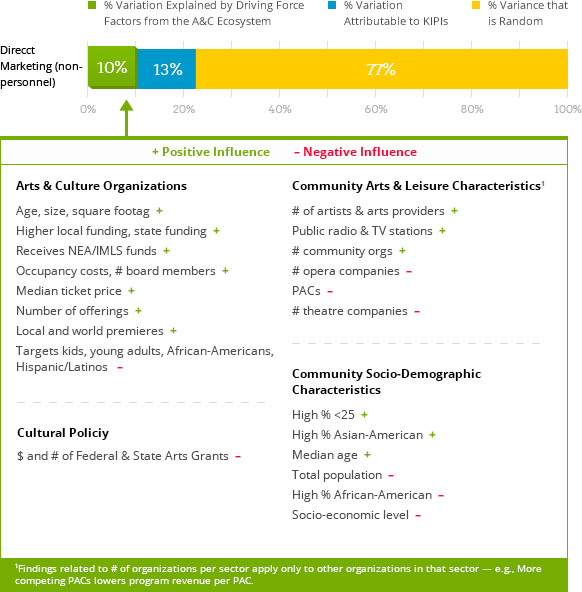Index-Specific Drivers Program Revenue
What Drives Program Revenue?

What Drives Program Revenue?
What organizational characteristics affect this performance?
-
Program revenue, which includes all revenue earned through the attraction of attendees and participants, increases with organizational age, square footage, budget size, the number of programmatic offerings, number of local premieres, the amount spent on marketing and on programming, the number of subscribers/members, total in-person attendance, targeting kids or young adults, and being awarded NEA or IMLS grants.
-
When organizations receive higher levels of support from local or state government, present higher numbers of world premieres, or target African-Americans or Hispanics/Latinos, program revenue tends to be lower.
How do community arts and leisure characteristics affect performance?
-
Program revenue tends to be higher for organizations in communities with higher levels of total arts dollar activity, more public broadcast dollar activity, and more leisure activities that act as complements to the art and cultural activity.
-
The more organizations in the arts education and symphony orchestra sectors, the higher earned revenue for all organizations in each sector. By contrast, more sector competitors in the art museum, dance, music, opera, PAC, or theatre sectors drives down program revenue for organizations in each of these sectors.
How do socio-demographic characteristics of the community affect performance?
-
Program revenue is higher for organizations in communities where total population is higher and the socioeconomic level is higher.
-
As the median age or percentage of the population either Asian-American or African-American increase, program revenue levels go down.
What impact does cultural policy have on performance?
-
Government grant activity in the local market had no effect on program revenue.
What Drives Total Marketing Expenses?

What Drives Total Marketing Expenses?
What organizational characteristics affect this performance?
-
Higher total marketing expenses tend to occur for older and larger-budget organizations, those with high levels of funding from local or state government, and those that receive NEA or IMLS grants. Total marketing expenses also are higher for those organizations with more administrative employees, larger overall staffs, who offer more programming, and present more local premieres.
-
Total marketing expenses tend to be lower for organizations that target those under 25, African-Americans or Hispanics/Latinos.
How do community arts and leisure characteristics affect performance?
-
Total marketing expenses are higher for organizations in communities with more public broadcast dollar activity, and more leisure activities, which in this case act as complements.
-
The more symphony orchestras, the higher the marketing budget tends to be for the organizations in this sector. By contrast, having more arts education organizations, art museums, community organizations, dance companies, music organizations, opera companies or theatre companies in a market tends to mean lower marketing budgets for those competing within each of these sectors.
How do socio-demographic characteristics of the community affect performance?
-
Total marketing expenses are lower in communities with larger populations, higher median age, a higher percentage of 18-24-year olds, or a higher percentage of Asian-Americans, African-Americans or Hispanics/Latinos.
What Drives Direct (non-staff) Marketing Expenses?

What Drives Direct (non-staff) Marketing Spend?
What organizational characteristics affect this performance?
-
Higher direct (non-staff) marketing expenses tend to occur for older organizations, those with larger budgets, larger boards, more square footage, higher occupancy expenses, those with high levels of funding from local or state government, and those that receive NEA or IMLS grants. Direct marketing expenses also are higher for those organizations with more total offerings, with a higher median ticket price, and present more local and world premieres.
-
Total marketing expenses tend to be lower for organizations that target those under 25, African-Americans or Hispanics/Latinos.
How do community arts and leisure characteristics affect performance?
-
Total marketing expenses are higher for organizations in communities with more public broadcast dollar activity, and more artists and arts providers.
-
The more community organizations, the higher the direct marketing budget tends to be for the organizations in this sector. By contrast, having more opera companies, PACs, or theatre companies in a market tends to mean lower direct marketing budgets for those competing within each of these sectors.
How do socio-demographic characteristics of the community affect performance?
-
Direct marketing expenses are higher in communities with higher median age, a higher percentage of people under 25, or a higher percentage of Asian-Americans. By contrast, they are lower in markets with a larger population, higher socio-economic level, or a high percentage of African-Americans.
What impact does cultural policy have on performance?
-
Higher state and federal government grant activity in the local market lowered direct marketing expenses.